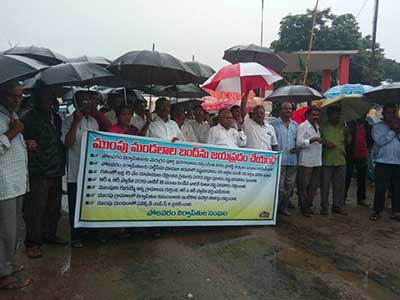GS-2 Development Processes and the Development Industry; GS3: Inclusive Growth and issues arising from it.
Key Phrases: Polavaram, Land acquisition, Rehabilitation
Why in news?
Many displaced people due to Polavaram project in Andhra Pradesh are ineligible for rehabilitation by the state government
Analysis:
What is Polavaram dam and why is it needed?
- A multi-purpose irrigation project. The dam across the Godavari River is under construction located in West Godavari District and East Godavari District in Andhra Pradesh state and its reservoir spreads in parts of Chhattisgarh and Orissa States also
- Project is multipurpose major terminal reservoir project on river Godavari for development of Irrigation, Hydropower and drinking water facilities
- It will irrigate nearly 3 lakh ha of land, generate hydel power with installed capacity of 960 MW and provide drinking water facilities to 540 enroute villages covering 25 lakh populations
Issue of displacement with Polavaram
- Displaces the highest number of people in India’s history of such projects: 106,006 families across 222 villages (total 373 habitations) in Andhra Pradesh, upon completion
- The R&R package includes compensating people for their agricultural land; banjar land has not been surveyed or included in the package While tribal have depended on banjar land for decades
- According to the Land Acquisition Act, 2013, those aged 18 years were eligible for compensation at the time of the survey. However, by the time the process started, a significant number of new youth population had become eligible for compensation
- Not providing R&R package to married women above 18 years, is an exclusionary process
Status of displacement in India
- Nearly five million people were displaced in India in 2019 - the highest in the world so far - according to ‘The Global Report on Internal Displacement (GRID 2020)
- Environmental and Development-induced Displacement: In order to achieve rapid economic growth, India has invested in industrial projects, dams, roads, mines, power plants and new cities which have been made possible only through massive acquisition of land and subsequent displacement of people
- “In India, 50 million people have been displaced in the last 50 years in the name of ‘national’ interest
- Internal displacement has also arisen from caste disputes (as in Bihar and Uttar Pradesh), religious fundamentalism and the ‘son-of-the soil policy (aggressive denial of residency and employment rights to non-indigenous groups)
- Religious-Jammu & Kashmir’s war between state forces and militants, had led to mass exodus of the Kashmiri Pandits due to religious fundamentalism
Impact of such displacement
- Marginalization -Land alienation, loss of access and control over forests, enforced displacement due to development projects and lack of proper rehabilitation, and indebtedness have been some of the key reasons for the marginalization of Adivasis
- Most displaced persons are assetless rural poor like landless labourers and small and marginal farmers. The tribals who comprise 8.08% of India’s population are estimated to be more than 40% of the displaced population. Dalits constitute 20% of displaced persons
- Impact of displacement and denial of access to forests have impacted lives and health, especially of the particularly vulnerable tribal groups (PVTGs)
- Displacement adversely affects women and studies have shown correlation between displacement and early marriage and falling health
- Adivasis live in close knit circles and depend on network of kinship but this disturbs it exposing them to further vulnerability
- They depend on collection MFP and non-timber products for survival and denial of that leads to poverty, malnutrition and cycle of debt
Efforts by government
- Government of India formulated a national policy for rehabilitation and resettlement by replacing the earlier policy of 2003
- Government of India came up with a comprehensive Land Acquisition and Resettlement and Rehabilitation (LARR) Act, 2013. The Act provides for rehabilitation & resettlement and combines it with land acquisition so the former does not get neglected.
- Comprehensive rehabilitation and resettlement package is provided for those who lost their livelihood support which includes the landless and tenants. The Act also provides for schools and playgrounds, health centers, roads and electric connections and assured sources of safe drinking water for each family
Way ahead
- Transparent Rehabilitation, Resettlement: Government must implement resettlement packages making the ethnic communities/tribals materially better off to counter the narrative that development and modernisation is disastrous for tribals, who cannot cope with the change
- Maintain transparency, ensure economic welfare: The oustees must be provided complete information regarding the dam, submergence and subsequent displacement due to them. Project authorities and state government must rehabilitate the oustees with sustainable non-land based livelihoods where needed.
- Public Hearing: From the inception of planning of dam, through various stages of displacement and resettlement, it is to be expected that those likely to be negatively affected by the projects would be consulted and kept informed in such a way (public hearing, social audit) as to enable them to best rebuild their lives. Bureaucratic lassitude and insensitivity should not be tolerated.
- Ensure Tribal welfare: The Forest department must proactively involve the people in the forest villages about possible submergence and displacement. Tribal people share the problems of other rural people but they are even more dependent on forests and common property resources
- Environmental Impact Assessment: This should not be a one-off document but have to be carried out periodically along with social impact assessment. Members should be drawn preferably from environmentalist groups, academia and Civil Society
- Disaster preparedness: A Disaster Prediction Mechanism/vulnerability assessment should be developed which can provide early warning based on scientific inputs. Use of radio communication to broadcast such critical information should be undertaken
- Various cheap and effective solutions available as an alternate to dams. These alternative models, which include reviving traditional systems of water harvesting in various parts of Rajasthan and other parts of India, has changed the economy of farmers and also addressed drinking water problems in the region
Source: Down To Earth









